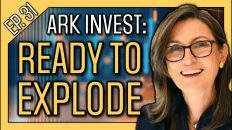Mentioned in Video:
- Inflation, Interest Rates, Retail Sales, Crypto | ITK with Cathie Wood ▶ https://www.youtube.com/watch?v=giydAxJTeow
- UM Surveys of Consumers ▶ https://data.sca.isr.umich.edu/charts.php
- CNN Fear and Greed Index ▶ https://money.cnn.com/data/fear-and-greed/
- AAII Sentiment Survey ▶ https://www.aaii.com/sentimentsurvey
- Inventories as % GDP ▶ https://fred.stlouisfed.org/series/A014RY2Q224SBEA
- Federal Open Market Committee (FOMC) Monetary Policy Meetings – https://www.federalreserve.gov/monetarypolicy.htm
- 12-month percentage change, Consumer Price Index, selected categories: https://www.bls.gov/charts/consumer-price-index/consumer-price-index-by-category-line-chart.htm
- FRED Economic Data – Total Vehicle Sales: https://fred.stlouisfed.org/series/TOTALSA
- Support the channel and get extra member-only benefits by joining us on Patreon: https://www.patreon.com/tickersymbolyou
⚡ In the Know with #CathieWood is a monthly @ARK Invest video series that talks about #stocks, #macroeconomics, and #technology. Here's a 15-minute supercut of #ARKInvest‘s latest episode, where Cathie Wood talks about indicators she thinks tell a much different story on #inflation and a #stockmarket bubble in companies like F (Ford stock) and GM (General Motors stock), not Tesla (TSLA stock), which is actually meeting demands despite a chip shortage and supply chain issues. Sources are provided for investors to come to their own conclusions.
Video Transcript:
00:00
cathie wood recently released her latest
00:02
episode of in the know a monthly video
00:04
series where she talks about stocks
00:05
economics and advanced technologies she
00:08
offered a ton of great insights around
00:09
the possible future of rate hikes
00:11
earnings calls for amazon and facebook
00:13
and what investors could be missing in a
00:15
few pretty important markets these
00:17
insights really require digging into the
00:19
data and as a result i recommend
00:20
watching the original episode in full
00:23
but if you're short on time i created a
00:25
super cut of the highlights and added
00:26
the right charts and sources for context
00:29
if you want to skip to a certain topic
00:30
or you just want my take on what kathy
00:32
would just said timestamps are enabled
00:34
for your convenience your time is
00:36
valuable so let's get right into it
00:38
starting with the supercut it's very
00:41
interesting that
00:43
companies
00:44
and people are setting up funds to bet
00:48
against innovation that's really
00:50
interesting i think history tells us you
00:52
shouldn't bet against innovation but we
00:54
are getting the description of
00:57
innovation stocks and i'm talking about
00:59
true disruptive innovation here we're
01:02
hearing
01:03
many out there dismissing these
01:05
strategies
01:06
as oh those are just stay-at-home
01:08
strategies they were
01:10
successful during the coronavirus
01:12
because they solved some problems we had
01:14
because of the coronavirus they're also
01:16
called
01:17
profitless tech strategies
01:20
well i can tell you there are a lot of
01:22
very
01:23
profitable very rapidly growing
01:26
companies in this innovation space
01:30
and i i've been through them with you
01:32
before but just for those who are new
01:34
they are dna sequencing adaptive
01:36
robotics energy storage artificial
01:40
intelligence and blockchain technologies
01:43
each platform alone
01:45
we believe has started to grow
01:48
exponentially they are converging as
01:50
well and the convergence we believe is
01:53
going to cause explosive growth and cash
01:55
flow dynamics the likes of which we
01:57
believe we've never seen before what
01:59
we're seeing on the monetary and fiscal
02:02
front right now many people after
02:05
today's employment report
02:08
are beginning to think that 50 basis
02:10
points is the number that the fed will
02:13
basically telegraph that it means
02:15
business and that it's going to head
02:18
inflation off at the pass if they do
02:20
however we think the stars are aligning
02:24
in such a way that they will get the
02:26
message very quickly that they don't
02:28
need to do much more they might want to
02:31
do the 50 basis points just to say okay
02:35
we're done for a while what's
02:36
interesting about the market's reaction
02:39
to
02:40
this possibility
02:42
is that strategists out in our world are
02:46
now
02:47
trying to leapfrog each other saying
02:49
okay i think it's at least three more
02:51
tightenings after that or four
02:54
i've even heard all together seven the
02:56
reaction you've seen in the equity
02:58
market recently is fear i think that the
03:01
fed is going to go too far too fast
03:04
because the economy is quite weak i
03:07
think the fed could do it overdo it
03:09
quite quickly and yet we look at what's
03:11
going on with oil prices right now quite
03:13
differently we do not believe that it is
03:16
an indicator of inflation we believe
03:19
it's a taxi increase it's it is a supply
03:23
shock that is true demand has not passed
03:26
uh where it was pre-covered so shortfall
03:29
in supply but it's a tax and it's it's a
03:33
terrible tax on the lower income
03:36
uh groups there probably is more
03:39
weakness brewing than many economists
03:42
and strategists i believe right now what
03:44
we are also focused on is that uh loss
03:47
of purchasing power is feeding through
03:50
to retail sales so retail sales in the
03:52
all-important december month were down
03:56
1.9
03:58
on the heels of a
04:00
0.2 percent increase in november with
04:03
inflation at 0.4.5.6
04:07
those numbers that retail sales number
04:10
would in real terms taking inflation
04:12
away have been down
04:14
two and a half percent and in november
04:17
also down
04:18
so consumption is falling
04:21
in uh the next few months we'll probably
04:25
uh see some sort of rebound we most
04:28
surely will because auto sales popped up
04:31
in in january we were also focusing on
04:35
what uh companies like facebook and
04:38
amazon are saying amazon reported
04:40
yesterday it's sales on a year-over-year
04:42
basis we're up only nine percent now it
04:46
was up against a very tough comparison
04:49
and i think on a two-year basis we've
04:51
still got solid growth but still nine
04:54
percent is even lower than the lowest
04:57
point during uh the 0809 crisis which
05:01
was 14 and a half percent true
05:04
amazon is a little bit more mature of a
05:05
company right now but nine percent i've
05:08
never seen out of out of amazon it was
05:10
facing tough comparisons in uh the
05:13
quarters prior to now and we saw nothing
05:15
like that nine percent facebook is
05:18
suggesting that for many reasons its
05:22
sales growth in this quarter will be
05:25
somewhere in the 3 to 11 range this is
05:28
the lowest ever it's never been in
05:29
single digits facebook has we think some
05:32
competitive problems but it did point
05:36
to weakness in the retail sector as did
05:39
google in in its report so we look to
05:42
the consumer sentiment surveys to give
05:45
us a sense of where we're going from
05:47
here
05:48
and if we did get another uh university
05:51
of michigan consumer sentiment survey
05:53
and it fell again to a new low it's
05:57
lower than at any time during 2020
06:00
during the coronavirus crisis and it is
06:02
heading for lows that we haven't seen
06:04
since the 0.809 prices so the consumers
06:08
doesn't like this loss of purchasing
06:10
power deeply buried in the survey
06:13
there is a part that says or ask the
06:16
consumer is now a good time to buy a car
06:20
but it is it has dropped to a new low
06:22
46.
06:24
uh it is lower than the low
06:27
in 0809 which was roughly a hundred
06:30
and precovet it was running at 150. so
06:34
it's about a third of that and it just
06:36
dropped to a new low
06:38
now this flies in the face of what we
06:40
saw in january auto sales
06:43
moving up quite strongly from 12.4
06:46
million units in december to 15 million
06:50
in january and what we believe has
06:52
happened there is the various automakers
06:55
had been building up inventories just
06:58
waiting to put in chips they are now
07:01
saying that that chip shortage is
07:04
alleviating uh so there have been people
07:07
waiting for uh their orders to be
07:09
delivered but if this survey is right
07:12
there's not going to be much follow
07:13
through i will say that the other thing
07:16
we're focused on is inventories
07:18
and in the face of the consumer feeling
07:21
this way we are paying uh extra
07:24
attention to inventories so for december
07:27
retail inventories went up four point
07:30
four percent think about that four point
07:32
four percent in december a big holiday
07:35
month after a two percent increase the
07:37
prior month now four point four percent
07:40
again you annualize things to get a
07:42
sense of the drama here if this were to
07:45
continue and it won't but you know
07:47
that's the equivalent of 50
07:50
plus
07:51
increase at an annual rate and nothing's
07:54
growing at that rate right now
07:56
we're also seeing wholesale inventories
07:58
backing up continuing to back up 2.1
08:01
percent after a 1.7 percent the prior
08:04
month and in the gdp report that was
08:06
reported for the fourth quarter we saw a
08:09
massive increase in inventory so the
08:12
real gdp increased 6.9
08:14
but 4.9 percentage points of that was
08:18
inventories real final sales were about
08:21
two percent so after a 0.1
08:25
increase in the third quarter so real
08:28
demand here is quite sluggish partly
08:32
because what real disposable personal
08:34
income is falling purchasing power is
08:37
falling capital spending is also doing
08:41
pretty well and i think automation is
08:44
going to surprise on the high side of
08:46
expectations as companies try to
08:50
try to counter
08:51
the input cost inflation particularly
08:55
energy
08:57
and and other raw materials
09:00
one of the reasons we are facing a shock
09:03
in
09:04
the oil industry
09:06
is esg
09:08
it is very well intentioned of course
09:11
esg if oil companies stopped spending on
09:14
fossil fuels in order to maintain a
09:17
position in
09:19
corporate pension plans and so forth oil
09:22
prices would go to the moon now a lot of
09:26
people
09:27
laugh at the comparison to whale oil
09:29
prices as we were shifting from whale
09:31
oil for our lighting needs
09:34
to fossil fuels but if you look at the
09:37
history supply shock
09:39
did occur because a whale oil
09:41
manufacturers saw the writing on the
09:43
wall and just pulled out in terms of
09:45
investing and the price was extremely
09:49
volatile
09:51
i am very surprised to see
09:53
oil above 90 90
09:56
per barrel but that is causing a couple
09:59
of things to happen here demand
10:00
destruction and private shale oil
10:04
producers are now ramping back up again
10:08
equities as you know they did move to an
10:10
all-time high but the internals of the
10:12
market last year were not good the
10:16
ratio of new lows to new highs was as
10:21
high as it's been since 1999.
10:24
in 1999 it was the value stocks that
10:28
were hitting new lows as everyone was
10:30
racing into the internet in this last
10:32
year
10:33
it has been
10:35
our kinds of stocks that were hitting
10:38
new lows
10:40
as value stocks were hitting all-time
10:42
highs as you know the right thing to
10:45
have done during
10:46
uh the late 90s when that ratio behaved
10:49
that way was to move away from the new
10:52
highs into the new lows and i think the
10:55
same is true today and i'll just give
10:58
you a preview of what may happen here
11:02
you know i was very interested after
11:04
ford said that the demand for its f-150
11:09
lightning ev was so much stronger than
11:11
than it expected its stock exploded i
11:15
want our auto manufacturers to be very
11:18
successful in the ev space but to see
11:21
its stock
11:23
jump
11:24
to highs that it had not seen
11:27
since 2000 what that move
11:30
said to me is oh my goodness investors
11:33
don't understand
11:35
that 97 to 98
11:38
of its sales base is gas-powered cars
11:42
and we believe that the shift toward
11:44
electric is accelerating here
11:46
oil prices being one reason but also
11:49
lower lower prices being another as
11:52
battery costs come down we're also
11:55
seeing a lot of confusion in the
11:58
more mature growth area of innovation
12:01
facebook is facing real competition and
12:04
it tick-tock is the is of course the
12:07
reason it's also
12:09
under pressure because apple is not
12:12
giving it or allowing it to have as much
12:14
information about users and has put in
12:18
place new privacy objectives and rules
12:20
facebook was one of the stocks hitting
12:22
all-time highs
12:24
now i have spoken to
12:27
some really good
12:29
value investors who've been doing this
12:31
all their lives and asked them if
12:34
interest rates were to move into the two
12:37
to three percent range let's say as
12:38
measured by the long-term treasury yield
12:41
which parts of the market given where we
12:43
are now uh would be hit and the answer
12:47
that i found most interesting and that i
12:49
i think we've just
12:51
seen in facebook
12:53
is it would be the more mature growth
12:56
companies that are facing some
12:57
competition and not the the super growth
13:01
companies that are just entering into
13:04
their exponential growth trajectories i
13:08
often use that
13:10
during the tekken telecom bubble i saw
13:13
investors you know falling all over each
13:15
other trying to one-up each other to get
13:18
a bigger tech position because tech in
13:20
the
13:21
indexes had moved to 35 percent so we
13:25
saw many portfolios with 40 50
13:28
tech again they needed to outperform
13:30
that
13:31
index and of course that was exactly the
13:34
wrong thing to do
13:36
but it was mass psychology it was a very
13:39
interesting time today we have the same
13:42
thing going on in reverse we have
13:45
investors shying away in fact running
13:48
for the hills uh and the hills in this
13:50
case are their benchmarks everyone needs
13:52
to get close to that benchmark and they
13:54
all look alike if you look at the top 10
13:57
in nasdaq top 10 in s p the overlap is
14:00
astonishing these benchmarks have really
14:03
i think done a disservice to the
14:05
allocation of capital but that said
14:08
investors are
14:09
running for the hills uh when when
14:11
there's volatility fear around inflation
14:14
and interest rates and we think that
14:16
that decision is going to prove to be
14:19
just as incorrect as uh the decision to
14:22
move
14:23
on mass in in the late 90s the consumer
14:27
is reacting violently
14:29
to this
14:31
loss of purchasing power so i don't
14:33
think it's going to feed inflation i
14:35
think it's going to feed this uh
14:38
negative sentiment that the consumer has
14:41
been feeling so the big theme of this
14:42
episode of in the know is not being able
14:45
to see the forest for the trees
14:46
commentators are labeling all growth
14:48
stocks as stay-at-home stocks or
14:50
profitless tech strategies instead of
14:52
looking at these stocks business by
14:53
business looking at only the top-line
14:55
gdp number instead of digging into the
14:58
data and seeing that over two-thirds of
14:59
that gdp growth was actually attributed
15:02
to building inventories even during the
15:04
holiday season when these sales should
15:06
be at their strongest seeing auto sales
15:08
go up for a month and attributing it to
15:10
demand when in reality the chip shortage
15:12
caused the backlog of orders that are
15:14
just now getting filled many of these
15:16
indicators are lower now than they were
15:18
at their bottom in march of 2020 and
15:20
back then the fed was quick to step in
15:22
the danger now is that the fed might
15:24
keep raising interest rates too far too
15:26
fast making today's relatively weak
15:28
economy even weaker by the time these
15:31
subtle data points impact the highest
15:32
level numbers like gdp it could already
15:35
be too late to course correct based on
15:37
kathy wood's commentary i think there
15:39
are a few easy things that we should
15:41
keep track of to assess overall economic
15:43
health the health of the market and the
15:45
mass psychology of investors that she's
15:47
talking about first let's talk about
15:49
consumer sentiment if people feel their
15:51
dollar isn't going very far they're
15:53
going to stop spending or at least slow
15:55
it down that would show up in consumer
15:57
sentiment earlier than it shows up in
15:59
actual earnings reports there are a few
16:01
great places to track consumer sentiment
16:04
depending on how deep down this rabbit
16:05
hole you want to get kathy wood often
16:07
cites the surveys of consumers by the
16:09
university of michigan this survey gets
16:12
deep in the weeds with questions about
16:13
personal finance savings and retirement
16:15
broad economic conditions and even
16:18
sentiment around vehicle buying
16:19
conditions which was nearing lows not
16:21
seen since 2008 i'm not saying we should
16:23
all be tracking every chart in this
16:25
survey every month but it could be a
16:27
good thing to bookmark and check in on
16:29
whenever you're thinking about it taking
16:31
things one level up we have cnn's fear
16:33
and greed index this one is more about
16:35
the market and less about the economy
16:37
but it's a great daily roll up of
16:38
different ways to think about the
16:40
market's health the indicator on this
16:42
fear and greed index that i want to
16:43
point out is the very bottom one called
16:46
stock price strength this shows the
16:48
number of stocks hitting yearly lows
16:50
versus those hitting yearly highs the
16:52
worry here isn't just when the number of
16:54
52-week lows outnumbers the highs it's
16:56
actually when the market keeps going up
16:58
while this is happening because that
17:00
means the market's performance is
17:01
getting concentrated into fewer and
17:03
fewer companies which is a reasonable
17:05
definition of a bubble so if you look at
17:08
the plot of the s p 500 right above this
17:10
which is trending upwards and compare it
17:12
to the stock price strength chart which
17:14
is trending downwards you can get a
17:16
better sense of the overall health of
17:17
the index the third and easiest to track
17:20
sentiment survey is the american
17:21
association of individual investors
17:24
which only asks one question once a week
17:26
what direction do aaii members feel the
17:29
stock market will be in the next six
17:31
months this last week the week ending
17:33
january 26 2022 was actually the one
17:36
year high for bearishness indicating
17:38
that the pain may not yet be over but a
17:40
lot of it could already be priced in the
17:42
other indicator i want to point out is
17:44
the one that i feel sits at the heart of
17:46
kathy wood's thesis on the market which
17:48
is the private inventory's contribution
17:50
to real gdp this is the 4.9 percent that
17:52
inventories are contributing to the
17:54
overall 6.9 growth in gdp that kathy
17:57
wood has mentioned which is near record
17:59
highs when inventories stay high it
18:01
means real demand is low which makes
18:03
sense based on consumer sentiment being
18:05
weighed down the other thing to point
18:07
out is how spiky and volatile these
18:09
inventory readings have been lately
18:11
which to me means that supply chain
18:13
issues are still very real so what i'm
18:15
looking for now is for consumer
18:17
sentiment to rise and stabilize stock
18:19
price strength to get back to normal and
18:21
for the contributions of the inventories
18:23
to gdp to fall and stay down in my
18:26
opinion if the fed really watched this
18:28
set of indicators they wouldn't be so
18:30
quick to sharply raise interest rates
18:32
comment below or tweet me at ticker
18:33
symbol u with your thoughts on these
18:35
supercuts in general and on this episode
18:37
specifically do you find these summaries
18:39
and sources helpful do you think kathy
18:41
wood is right to look at inventory
18:43
buildups market health and consumer
18:44
sentiment or should investors be looking
18:47
elsewhere i'm excited to hear your
18:48
thoughts either way stay long stay
18:50
strong and thanks for watching until
18:52
next time this is ticker symbol you my
18:55
name is alex reminding you that the best
18:57
investment you can make
18:59
is in you
If you want to comment on this, please do so on the YouTube Video Here














